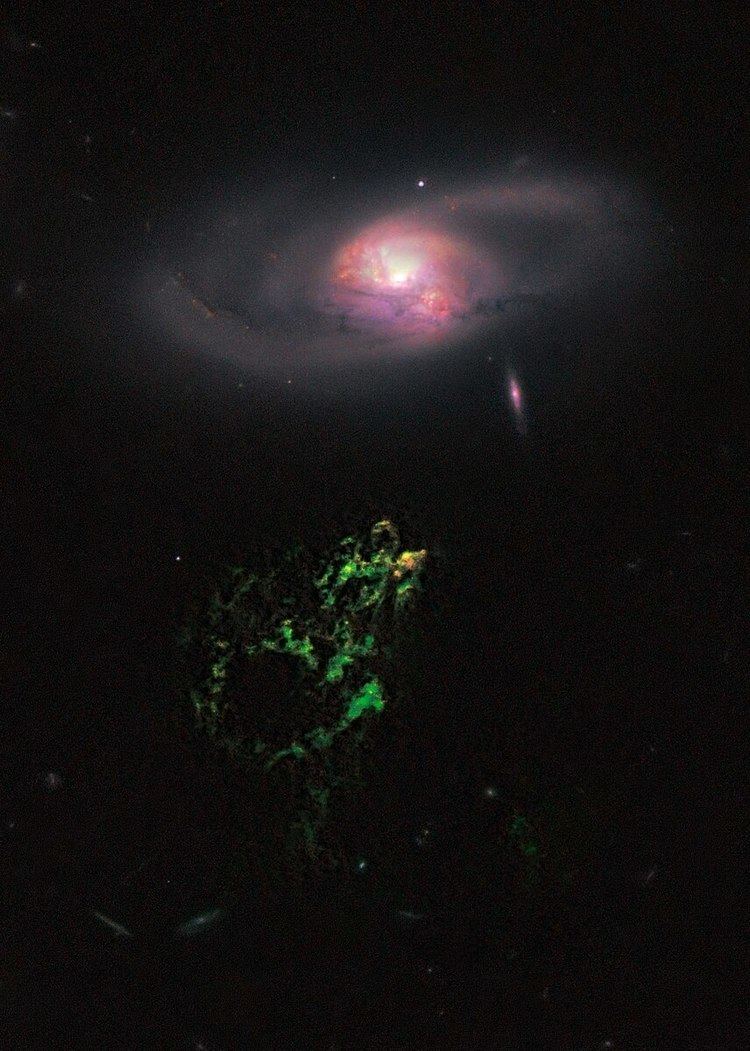Object type Quasar ionization echo Right ascension 09 41 03.81 Distance 6.5×10 | Declination +34° 43′ 34.3″ | |
 | ||
Other designations SDSS J094103.80+344334.2 | ||
Hanny's Voorwerp /ˈhʌniz ˈvɔːr.wɛərp/, (Dutch for Hanny's object) is a rare type of astronomical object called a quasar ionization echo. It was discovered in 2007 by Dutch schoolteacher Hanny van Arkel, while she was participating as a volunteer in the Galaxy Zoo project. Photographically, it appears as a bright blob close to spiral galaxy IC 2497 in the constellation Leo Minor.
Contents
Description
Hanny's Voorwerp (HsV) is about the size of a small galaxy and has a central hole over 16,000 light years across. In an image taken with the HST, HsV is colored green, a standard false color that is used to represent the presence of several luminous emission lines of glowing oxygen. HsV has been shown to be at the same distance from Earth as the adjacent galaxy IC 2497, which is about 650 million light-years away.
Star birth is occurring in the region of HsV that faces IC 2497. Radio observations indicate that this is due to an outflow of gas arising from the IC 2497's core which is interacting with a small region of HsV to collapse and form stars. The youngest stars are several million years old.
A 40-page comic and associated promotional offers about HsV and the story surrounding it were presented at the 24th Dragon Con in Atlanta on 3 September 2010, as well as first pictures of HsV from the Hubble Space Telescope. The launch was streamed live on UStream.
Hypotheses
One hypothesis suggests that HsV consists of remnants of a small galaxy showing the impact of radiation from a bright quasar event that occurred in the center of IC 2497 about 100,000 years before how it is observed today. The quasar event is thought to have stimulated the bright emission that characterizes HsV. The quasar might have switched off in the last 200,000 years and is not visible in the available images. This might well be due to a process known as AGN feedback.
One possible explanation for the missing light-source is that illumination from the assumed quasar was a transient phenomenon. In this case, its effects on HsV would be still visible because of the distance of several tens of thousands of light years between HsV and the quasar in the nearby galaxy: HsV would show a "light echo" or "ghost image" of events that are older than those currently seen in the galaxy.
On 17 June 2010, a group of researchers at the European VLBI Network (EVN) and the UK’s Multi-Element Radio Linked Interferometer Network (MERLIN), proposed another related explanation. They hypothesized that the light comes from two sources: (1) a supermassive black hole at the center of IC 2497, and (2) light produced by an interaction of an energetic jet from the black hole and the gas surrounding IC 2497.
Voorwerpjes
In February 2012, W. C. Keel and others published a paper in the Monthly Notices of the Royal Astronomical Society. As a result of the interest in similar ionized clouds for the study of both the history and obscuration of Active Galactic Nucleus (AGN), participants in the Galaxy Zoo (GZ) project carried out a wide search for such clouds using data from the Sloan Digital Sky Survey (SDSS). This search yielded a list of 19 galaxies with AGN-photoionized clouds detected to beyond 10 kiloparsecs from the nuclei. These were nicknamed 'Voorwerpjes' from the Dutch for 'small objects'.
In May 2015, W.C. Keel and others published a study in the Astrophysical Journal. This studies 8 of the original 19 Voorwerpjes in greater detail, focusing on 'the host-galaxy properties and origin of the gas.' Among the telescopes used was the 6 meter BTA-6 at the Special Astrophysical Observatory of the Russian Academy of Science.
In August 2013, F. Schweizer and others published a paper in the Astrophysical Journal. This reports the finding of a Voorwerpje on the outskirts of the well-studied NGC 7252.
Other examples of Voorwerpjes include the galaxies UGC 12914 and 12915, which are merging. While in the process of merging, the smaller UGC 12915 has formed a small voorwerpje near it.
Extended X-ray emission in IC 2497
In April 2016, a study was published in the Monthly Notices of the Royal Astronomical Society using data gathered by the Chandra X-ray Observatory in January 2012. The study found extended soft X-ray emission in IC 2497 which suggested the presence of a bubble or cavity surrounding the AGN. The authors hypothesize that this could be due to the bubble being inflated by the AGN, or by a past luminous quasar.
